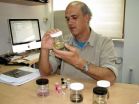(Press-News.org) Centipedes, those many-legged creatures that startle us in our homes and gardens, have been genetically sequenced for the first time. In a new study in the journal PLoS Biology, an international team of over 100 scientists today reveals how this humble arthropod's DNA gave them new insight into how life developed on our planet.
Centipedes are members of the arthropods, a group with numerous species including insects, spiders and other animals. Until now, the only class of arthropods not represented by a sequenced genome was the myriapods, which include centipedes and millipedes. For this study, the researchers sequenced the genome of the centipede Strigamia maritima, because its primitive features can help us understand more complex arthropods.
According to Prof. Ariel Chipman, senior co-author of the study and project leader at the Hebrew University of Jerusalem's Alexander Silberman Institute of Life Science, the genetic data reveal how creatures transitioned from their original dwelling-place in the sea to living on land.
"The use of different evolutionary solutions to similar problems shows that myriapods and insects adapted to dry land independently of each other," said Chipman. "For example, comparing the centipede and insect genomes shows that they independently evolved different solutions to the same problem shared by all land-dwelling creatures -- that of living in dry air."
According to Chipman, the study found that despite being closely related to insects, the centipede lacks the olfactory gene family used by insects to smell the air, and thus developed its own air-sniffing ability by expanding other gene families not present in insects.
In addition, Chipman said, this specific group of centipedes live underground and have lost their eyes, together with almost all vision genes and genes involved in the body's internal clock. They maintain enhanced sensory capabilities enabling them to recognize their environment and capture prey.
Published in the latest edition of PLoS Biology, the research is a collaborative effort by over 100 scientists from 50 institutions. Thousands of human-hours went into looking at specific genes in the centipede genome, with each researcher looking at a limited set of genes or at specific structural characteristics to address specific questions.
Other leaders of the international research effort include Dr. Stephen Richards, Baylor College of Medicine; Dr. David Ferrier, University of St. Andrews; and Prof. Michael Akam of Cambridge University. The research paper is titled "The First Myriapod Genome Sequence Reveals Conservative Arthropod Gene Content and Genome Organisation in the Centipede Strigamia maritima."
While early studies of genomics focused on humans, as sequencing equipment and expertise became more readily available, researchers expanded into animals directly relevant to human wellbeing. In the latest research, genomic sequencing has become more broad-based, investigating the workings of the world around us.
In explaining the purpose of the research, Hebrew University's Chipman said: "If we have a better understanding of the biological world around us, how it operates, and how it came to be as it is, we will ultimately have a better understanding of ourselves."
According to Chipman, the research will have applications for other researchers ranging from conservation to dealing with crop pests.
INFORMATION:
The Alexander Silberman Institute of Life Sciences is the largest research institute in the Hebrew University's Faculty of Sciences. Members of the Institute of Life Sciences devote themselves to two parallel and complementary endeavors: advanced scientific research at the forefront of contemporary biological sciences, and broad-range biological education aimed at endowing the students with the knowledge, skills and research tools essential for participating in the continuously changing field of life sciences. The Institute of Life Sciences maintains diverse undergraduate (B.Sc.) and graduate (M.Sc. and Ph.D.) teaching programs.
The Hebrew University of Jerusalem is Israel's leading academic and research institution. Serving over 23,000 students from 85 countries, it produces a third of Israel's civilian research. For more information, visit http://new.huji.ac.il/en.
Learning-related brain activity in Parkinson's patients improves as much in response to a placebo treatment as to real medication, according to a new study by researchers at the University of Colorado Boulder and Columbia University.
Past research has shown that while Parkinson's disease is a neurological reality, the brain systems involved may also be affected by a patient's expectations about treatment. The new study, published in the journal Nature Neuroscience, explains how the placebo treatment -- when patients believe they have received medication when they have ...
Endangered Snake River sockeye salmon are regaining the fitness of their wild ancestors, with naturally spawned juvenile sockeye migrating to the ocean and returning as adults at a much higher rate than others released from hatcheries, according to a newly published analysis. The analysis indicates that the program to save the species has succeeded and is now shifting to rebuilding populations in the wild.
Biologists believe the increased return rate of sockeye spawned naturally by hatchery-produced parents is high enough for the species to eventually sustain itself in ...
MAYWOOD, Il. - An award-winning study by a Loyola University Chicago Stritch School of Medicine researcher has documented how homeless, mentally ill women in India face a vicious cycle:
During psychotic episodes, they wander away from home, sometimes for long distances, and wind up in homeless shelters. They then are returned to their families before undergoing sufficient psychosocial rehabilitation to deal with their illness. Consequently, they suffer mental illness relapses and wind up homeless again.
"The study illustrates how there must be a balance between reintegrating ...
While the turkey you eat on Thursday will bring your stomach happiness and could probably kick-start an afternoon nap, it may also save your life one day.
That's because the biological machinery needed to produce a potentially life-saving antibiotic is found in turkeys. Looks like there is one more reason to be grateful this Thanksgiving.
"Our research group is certainly thankful for turkeys," said BYU microbiologist Joel Griffitts, whose team is exploring how the turkey-born antibiotic comes to be. "The good bacteria we're studying has been keeping turkey farms healthy ...
How is it that vultures can live on a diet of carrion that would at least lead to severe food-poisoning, and more likely kill most other animals? This is the key question behind a recent collaboration between a team of international researchers from Denmark's Centre for GeoGenetics and Biological Institute at the University of Copenhagen, Aarhus University, the Technical University of Denmark, Copenhagen Zoo and the Smithsonian Institution in the USA. An "acidic" answer to this question is now published in the scientific journal Nature Communications.
When vultures eat ...
Who knew Blu-ray discs were so useful? Already one of the best ways to store high-definition movies and television shows because of their high-density data storage, Blu-ray discs also improve the performance of solar cells -- suggesting a second use for unwanted discs -- according to new research from Northwestern University.
An interdisciplinary research team has discovered that the pattern of information written on a Blu-ray disc -- and it doesn't matter if it's Jackie Chan's "Supercop" or the cartoon "Family Guy" -- works very well for improving light absorption across ...
New York, NY, November 25, 2014 - Testosterone (T) therapy is routinely used in men with hypogonadism, a condition in which diminished function of the gonads occurs. Although there is no evidence that T therapy increases the risk of prostate cancer (PCa), there are still concerns and a paucity of long-term data. In a new study in The Journal of Urology®, investigators examined three parallel, prospective, ongoing, cumulative registry studies of over 1,000 men. Their analysis showed that long-term T therapy in hypogonadal men is safe and does not increase the risk of ...
LAWRENCE -- Physicists at the University of Kansas have fabricated an innovative substance from two different atomic sheets that interlock much like Lego toy bricks. The researchers said the new material -- made of a layer of graphene and a layer of tungsten disulfide -- could be used in solar cells and flexible electronics. Their findings are published today by Nature Communications.
Hsin-Ying Chiu, assistant professor of physics and astronomy, and graduate student Matt Bellus fabricated the new material using "layer-by-layer assembly" as a versatile bottom-up nanofabrication ...
The bacterium Helicobacter pylori is strongly associated with gastric ulcers and cancer. To combat the infection, researchers at University of California, San Diego School of Medicine and Jacobs School of Engineering developed LipoLLA, a therapeutic nanoparticle that contains linolenic acid, a component in vegetable oils. In mice, LipoLLA was safe and more effective against H. pylori infection than standard antibiotic treatments.
The results are published online Nov. 24 in the Proceedings of the National Academy of Sciences.
"Current H. pylori treatments are facing ...
Medford/Somerville, Mass--Researchers in human genetics have known that long nucleotide repeats in DNA lead to instability of the genome and ultimately to human hereditary diseases such Freidreich's ataxia and Huntington's disease.
Scientists have believed that the lengthening of those repeats occur during DNA replication when cells divide or when the cellular DNA repair machinery gets activated. Recently, however, it became apparent that yet another process called transcription, which is copying the information from DNA into RNA, could also been involved.
A Tufts ...




